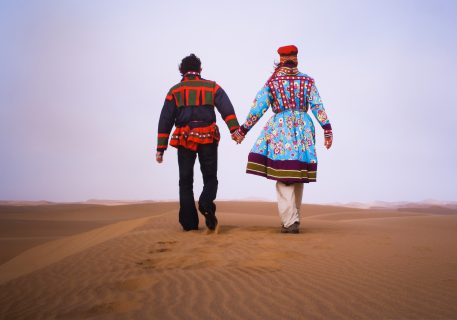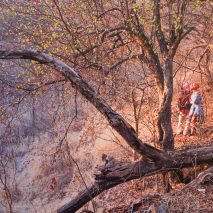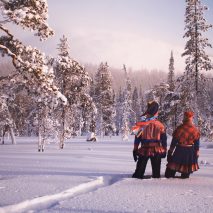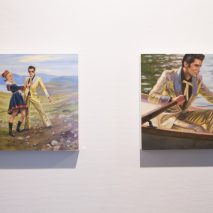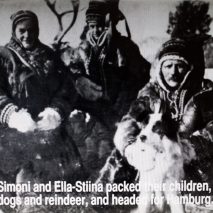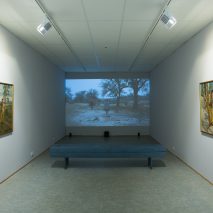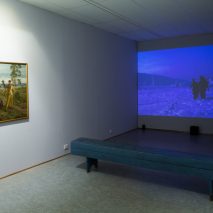Exhibitors: Annika Dahlsten and Markku Laakso.
This series of works follows the artists Annika Dahlsten and Markku Laakso as they travel from Lapland via Hamburg to Africa, investigating otherness and authenticity. These photographic and video works are based on the journey that Laakso’s great grandfather made to Hamburg Zoo, where he and his family lived on display as Sámi people. The works open up viewpoints inherent in the background story on identity, rootlessness and belonging to a place. The artists ask: Can a Sámi in a zoo be genuine? What is indigenousness, who are we talking about when we talk about otherness?
The exhibition by Annika Dahlsten and Markku Laakso follows the artists on their trip from Lapland via Hamburg to Africa. They make a trip to explore otherness and originality. The photographs and videos of the exhibition are based on a trip Laakso’s grand-grandfather made to Hamburg Zoo in order to be exhibited there as Sámi together with his family. The exhibition reflects on identity, rootlessness and belonging to a place, arising from the experiences of Laakso’s grand-grandfather. Can you find something positive about displaying a Sámi in a zoo? What are aboriginal peoples and about whom do we speak when we say that someone is different?
In 1925, Simoni Laakso from Enontekiö took his family and reindeer with him to Hamburg Zoo. They lived there on the exhibition premises for half a year, entertaining the public with their everyday life – something exotic for the spectators. The premises were set up by Carl Hagenbeck, a European importer of animals who came up with the concept of “the modern zoo”. These human exhibition objects – aboriginal and tribal people – were displayed as something different. The Laakso family also travelled to other German zoos during their six months in Germany; there, they entertained the visitors by sitting around a campfire, preparing food and taking care of their reindeer.
The artist duo visited the same zoo in Hamburg, making a performance in the area where Hagenbeck’s human zoo was launched. Dahlsten and Laakso also travelled to South Africa as fictional nomads in order to experience personally what it is like to be different and strange. They camped in the desert as if in the highlands of Lapland and discovered places in Namibia, Botswana and South Africa where the landscape reminded them of Enontekiö.
In addition to Campfire in a Zoo, we will also display paintings by Markku Laakso. Laakso was born in Enontekiö and grew up in Inari, in Lapland, and his art rises strongly from his northern identity. His paintings depict his childhood idols Elvis and the Sámi boy, which represent the different aspects of his personality. We sense a collision between two different cultures and a longing to belong to both.
The paintings make references to the Golden Age of Nordic art that occurred in the late 1800s. Influences from pop culture, socialist realism, the Finnish sauna, and wilderness traditions are also at work in Laakso’s art.
The story starts off with Markku Laakso’s Sámi great grandfather Simoni Laakso, who, along with his family and reindeer, left Enontekiö in 1925 to appear in Hamburg Zoo. This was for a ‘human exhibit’ staged by Carl Hagenbeck, a European animal importer and creator of the modern concept of the zoo. These ‘human exhibits’ put ‘othernesses’ – aboriginal peoples and tribes – on display to Europeans. The Laakso family toured in German zoos for half a year, entertaining spectators with their life in camp: spending time round the campfire, cooking and tending reindeer.
When making the set works for Campfire in a Zoo, the artist couple went to that same zoo in Hamburg and staged a performance in the same open area where Hagenbeck’s human zoo began. Dahlsten and Laakso also journeyed as fictive Sámi-nomad characters to southern Africa, where they felt their own otherness and alienness. They camped in the desert as they would in the fells of Lapland, seeking out places in Namibia, Botswana and South Africa that most reminded them of landscape in Enontekiö.
Annika Dahlsten is a printmaker / animator (1975) and Markku Laakso (1970) a painter. Together they work with photography, video art and performance. Their work has been on display in many Finnish museums and galleries, and they have made performances for example in Berlin, Hamburg and Windhoek, Namibia.
Homepage
Markku Laakso


